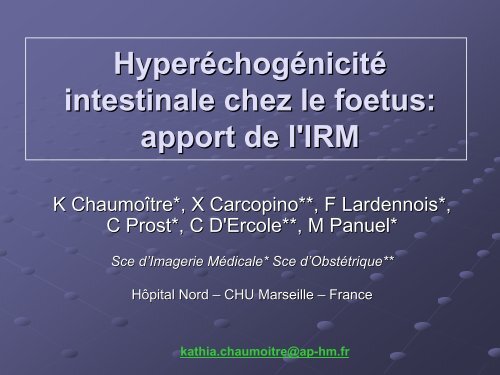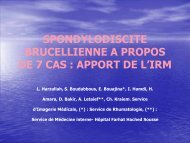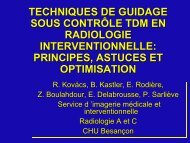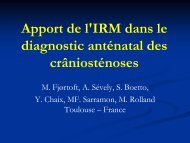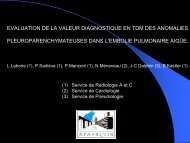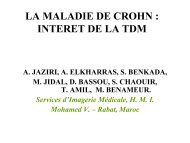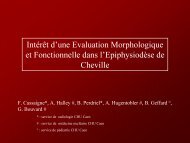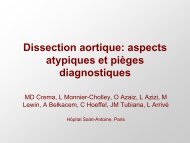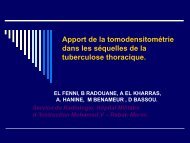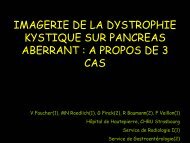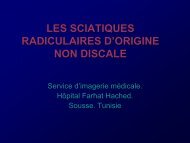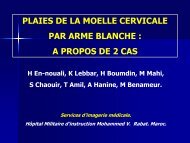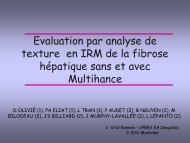Hyperéchogénicité intestinale chez le foetus: apport de l'IRM
Hyperéchogénicité intestinale chez le foetus: apport de l'IRM
Hyperéchogénicité intestinale chez le foetus: apport de l'IRM
Create successful ePaper yourself
Turn your PDF publications into a flip-book with our unique Google optimized e-Paper software.
Hyperéchog<br />
chogénicité<br />
<strong>intestina<strong>le</strong></strong> <strong>chez</strong> <strong>le</strong> <strong>foetus</strong>:<br />
<strong>apport</strong> <strong>de</strong> <strong>l'IRM</strong><br />
K Chaumoître*, X Carcopino**, F Lar<strong>de</strong>nnois*,<br />
C Prost*, C D'Erco<strong>le</strong><br />
Erco<strong>le</strong>**, M Panuel*<br />
Sce d’Imagerie Médica<strong>le</strong>* M<br />
Sce d’Obstétrique**<br />
trique**<br />
Hôpital Nord – CHU Marseil<strong>le</strong> – France<br />
kathia.chaumoitre@ap-hm.fr
Contexte<br />
Hyperéchog<br />
chogénicité <strong>intestina<strong>le</strong></strong> (HEI)<br />
1%<br />
<strong>de</strong>s échographies obstétrica<strong>le</strong>s<br />
trica<strong>le</strong>s 1,2,3<br />
1/3 HEI mauvais pronostic 4 (anomalies<br />
chromosomiques, malformations, mucoviscidose,<br />
infections fœta<strong>le</strong>s, f<br />
retard <strong>de</strong> croissance…)<br />
IRM fœta<strong>le</strong> f<br />
abdomina<strong>le</strong> indications encore<br />
limitées<br />
5- 7 . Aucune étu<strong>de</strong> sur l’<strong>apport</strong>l<br />
<strong>de</strong> l’IRM l<br />
en<br />
cas <strong>de</strong> grê<strong>le</strong> hyperéchog<br />
chogène.
Matériel et métho<strong>de</strong>sm<br />
Etu<strong>de</strong> rétrospective r<br />
<strong>de</strong> 17 fœtus f<br />
(24-34 SA) avec<br />
HEI du grê<strong>le</strong> 3<br />
Suivi échographique mensuel, IRM foeta<strong>le</strong>,<br />
caryotype, recherche <strong>de</strong> la mucoviscidose<br />
(∆F-508)<br />
et bilan viral (CMV, EBV, HSV, PB19)<br />
HEI<br />
isolée e ou associée à <strong>de</strong>s<br />
dilatations<br />
<strong>intestina<strong>le</strong></strong>s ou <strong>de</strong> l’ascite l
Matériel et métho<strong>de</strong>sm<br />
Protoco<strong>le</strong> IRM:<br />
sing<strong>le</strong>-shot shot T2-w w (HASTE)<br />
gradient echo T1-w<br />
Analyse 5- 7 : tail<strong>le</strong> et signal du grê<strong>le</strong> et du colon,<br />
ascite, , masse abdomina<strong>le</strong><br />
Suivi postnatal: examen clinique et échographie<br />
abdomina<strong>le</strong>
IRM norma<strong>le</strong>: 11 cas<br />
Suivi postnatal normal dans tous <strong>le</strong>s cas<br />
Il s’agissait s<br />
d’HEI d<br />
isolées<br />
Aspect du grê<strong>le</strong> normal en T2 (33 SA)<br />
Aspect du colon normal en T1 (28 SA)
IRM pathologique: 6 cas<br />
1 cas <strong>de</strong> duplication digestive (*) non diagnostiquée e en<br />
échographie avec ascite transitoire<br />
1 cas <strong>de</strong> “gros reins” sans anomalie digestive (non<br />
illustré) Évolution postnata<strong>le</strong> norma<strong>le</strong><br />
28 SA
IRM pathologique: 6 cas<br />
2 cas d’atrésies iléa<strong>le</strong>s<br />
opérées à la naissance<br />
Obstruction digestive avec dilatation iléa<strong>le</strong> (*) et microrectum () (27 SA)<br />
Opéré à la naissance pour atrésie grê<strong>le</strong> sur app<strong>le</strong>-peel
IRM pathologique: 6 cas<br />
2 diagnostics génétiques g<br />
<strong>de</strong> mucoviscidose IMG<br />
34 SA<br />
Obstruction digestive avec dilatation iléa<strong>le</strong> (*) en hypersignal T1 modéré<br />
et isosignal T2 associé à un microcolon () (34 SA)
On note la différence <strong>de</strong> signal <strong>de</strong>s anses distendues en amont <strong>de</strong> l’obstac<strong>le</strong>l<br />
entre <strong>le</strong>s 2 cas d’atrd<br />
atrésie du grê<strong>le</strong> et <strong>le</strong>s 2 cas <strong>de</strong> mucoviscidose<br />
Atrésie<br />
grê<strong>le</strong><br />
Dilatation iléa<strong>le</strong> (*) en hyposignal T2 franc et<br />
hypersignal T1 franc associée à un microrectum ()<br />
27 SA<br />
Mucoviscidose<br />
Dilatation iléa<strong>le</strong> (*) en signal intermediaire en T2 et<br />
discret hypersignal en T1 franc associée à un microrectum ()
Discussion<br />
HEI associée à une évolution postnata<strong>le</strong> défavorab<strong>le</strong>d<br />
dans<br />
un tiers <strong>de</strong>s cas:<br />
<br />
mucoviscidose, anomalies chromosomiques (T21) , malformations,<br />
infections congénita<strong>le</strong>s, nita<strong>le</strong>s, retard <strong>de</strong> croissance intra-ut<br />
utérin, mort in<br />
utero 8-23<br />
.<br />
La diapositive suivante résume r<br />
<strong>le</strong>s principa<strong>le</strong>s étu<strong>de</strong>s sur<br />
<strong>le</strong>s HEI. Sur un total <strong>de</strong> 1682 cas, la répartition r<br />
<strong>de</strong>s<br />
pathologies est la suivante:<br />
<br />
anomalies chromosomiques 6,7%, mucoviscidose 2,4%, infection<br />
congénita<strong>le</strong> nita<strong>le</strong> 3,3%, retard <strong>de</strong> croissance 6,1%.
Auteurs<br />
n<br />
Terme<br />
(SA)<br />
Evolution<br />
défavorab<strong>le</strong><br />
(%)<br />
Anomalies<br />
Chromosom.<br />
(%)<br />
MucoV<br />
(%)<br />
Infections<br />
(%)<br />
RCIU* (%)<br />
Mortalité<br />
périnata<strong>le</strong> †<br />
(%)<br />
Dicke & Crane [8]<br />
30<br />
15 - 34<br />
12 (40)<br />
1 (3)<br />
4 (14)<br />
0<br />
6 (21)<br />
4 (14)<br />
Nyberg et al. [10]<br />
95<br />
15 - 24<br />
45 (47)<br />
24 (25)<br />
0<br />
1 (1)<br />
13 (18)<br />
6 (8)<br />
Brom<strong>le</strong>y et al. [1]<br />
50<br />
14 - 24<br />
21 (42)<br />
8 (16)<br />
0<br />
0<br />
8 (19)<br />
5 (12)<br />
Hill et al. [2]<br />
32<br />
15 – 21<br />
11 ( 34)<br />
2 (6)<br />
0<br />
2 (6)<br />
4 (13)<br />
5 (17)<br />
Mul<strong>le</strong>r et al. [23]<br />
182<br />
14 – 34<br />
71 (39)<br />
8 (4)<br />
1 (1)<br />
7 (4)<br />
12 (7)<br />
23 (13)<br />
Slotnick et al. [3]<br />
145<br />
16 – 20<br />
20 (14)<br />
8 (6)<br />
7 (5)<br />
0<br />
0<br />
0<br />
Yaron et al. [14]<br />
79<br />
14 – 23<br />
36 (46)<br />
5 (6)<br />
2 (3)<br />
5 (6)<br />
5 (7)<br />
6 (8)<br />
Ghose et al. [17]<br />
60<br />
16 – 22<br />
17 (28)<br />
3 (5)<br />
3 (5)<br />
0<br />
6 (11)<br />
6 (11)<br />
Strocker et al. [16]<br />
131<br />
15 – 23<br />
38 (29)<br />
15 (11)<br />
0<br />
13 (10)<br />
8 (7)<br />
9 (8)<br />
Simon-Bouy et al. [19]<br />
682<br />
15 – 34<br />
209 (30.6)<br />
24 (3.5)<br />
20 (3)<br />
19 (2.8)<br />
28 (4.1)<br />
24 (3.5)<br />
Kesrouani et al. [22]<br />
196<br />
14-24<br />
80 (40.8)<br />
14 (7.1)<br />
3 (1.5)<br />
8 (4)<br />
13 (6.6)<br />
4 (2)<br />
Total<br />
1682<br />
14 - 34<br />
560 (33.3)<br />
112 (6.7)<br />
40 (2.4)<br />
55 (3.3)<br />
103 (6.1)<br />
92 (5.5)<br />
HEI : revue <strong>de</strong> la littérature<br />
RCIU Retard <strong>de</strong> Croissance Intra Utérin * Anomalies chromosomiques exclues<br />
† Anomalies chromosomiques et IMG exclues
Discussion<br />
Malgré 33,3% <strong>de</strong> mauvais pronostic postnatal, un intestin<br />
grê<strong>le</strong> hyperéchog<br />
chogène<br />
reste un signe échographique<br />
isolé<br />
dans 2/3 <strong>de</strong>s cas sans conséquence clinique<br />
Sa découverte d<br />
entraîne ne un bilan étiologique très s large,<br />
coûteux et générateur g<br />
<strong>de</strong> stress pour <strong>le</strong>s parents<br />
Place et <strong>apport</strong> <strong>de</strong> l’IRMl<br />
fœta<strong>le</strong> abdomina<strong>le</strong>?
Discussion<br />
Prise en charge habituel<strong>le</strong> <strong>de</strong>s HEI:<br />
<br />
<br />
Examen échographique soigneux à la recherche <strong>de</strong> malformations,<br />
<strong>de</strong> RCIU, d’anomalies d<br />
placentaires ou d’anomalies d<br />
du liqui<strong>de</strong><br />
amniotique 16<br />
Consultation génétique g<br />
recherche <strong>de</strong>s gènes g<br />
<strong>le</strong>s plus fréquents<br />
<strong>de</strong> la mucoviscidose <strong>chez</strong> <strong>le</strong>s parents (∆F-508)(<br />
508), , amniocentèse,<br />
caryotype 1,9,24<br />
Recherche d’une d<br />
infection (culture et PCR)<br />
<br />
Dans la majorité <strong>de</strong>s cas, toutes ces explorations sont<br />
négatives. . Parfois, l’hyperl<br />
hyperéchogénicité du grê<strong>le</strong> peut être<br />
rattachée à la déglutition d<br />
foeta<strong>le</strong> d’un d<br />
liqui<strong>de</strong> amniotique<br />
hémorragique<br />
25,26 .
Discussion<br />
Avec un tiers d’éd<br />
’évolution postnata<strong>le</strong> défavorab<strong>le</strong>d<br />
et 5,5%<br />
<strong>de</strong> décès d s périnatal, p<br />
il serait uti<strong>le</strong> <strong>de</strong> disposer d’examens d<br />
performants pour évaluer <strong>le</strong> pronostic foetal et adapter la<br />
prise en charge postnata<strong>le</strong> en cas d’HEI. d<br />
Il n’existe n<br />
pas actuel<strong>le</strong>ment d’examen d<br />
idéal.<br />
Certaines<br />
étu<strong>de</strong>s ont mis en avant <strong>de</strong>s anomalies dopp<strong>le</strong>r ainsi<br />
qu’une<br />
une élévation <strong>de</strong> l’AFPl<br />
2,27-29<br />
29<br />
. Aucun <strong>de</strong> ces facteurs a<br />
une va<strong>le</strong>ur diagnostique ou pronostique é<strong>le</strong>vée.<br />
e.
Discussion<br />
L’aspect du tube digestif normal en IRM fœta<strong>le</strong>f<br />
a été décrit<br />
et dépend d<br />
<strong>de</strong> l’âge l<br />
gestationnel 5- 6 . Schématiquement, <strong>le</strong><br />
colon et <strong>le</strong> rectum apparaissent en hypersignal T1 et sont<br />
mal visualisab<strong>le</strong>s en T2 (hyposignal(<br />
hyposignal). L’intestin L<br />
grê<strong>le</strong> est en<br />
hypersignal T2.<br />
Une obstruction digestive peut être évoquée e en IRM quand<br />
il existe <strong>de</strong>s dilatations digestives, <strong>de</strong>s anomalies du calibre<br />
du rectum (microrectum(<br />
microrectum) ) et/ou <strong>de</strong>s anomalies du signal du<br />
méconium<br />
5- 7 . Nos résultats r<br />
confirment ces données <strong>de</strong> la<br />
littérature.
Discussion<br />
IRM foeta<strong>le</strong> abdomina<strong>le</strong> uti<strong>le</strong> et performante<br />
signal spécifique<br />
du méconium<br />
visualisation et localisation d’une<br />
dilatation digestive<br />
diagnostic d’un d<br />
microcolon<br />
Dans notre petite série:<br />
IRM norma<strong>le</strong> (n=11) 100 % VPN
Discussion<br />
Dans notre série: s<br />
<br />
IRM anorma<strong>le</strong> échoG<br />
pathologique (en <strong>de</strong>hors <strong>de</strong> l’HEI) l<br />
Mais IRM <strong>apport</strong> diagnostique supplémentaire<br />
Diagnostic faci<strong>le</strong> d’un d<br />
microcolon obstruction digestive<br />
Signal digestif inhabituel dans <strong>le</strong>s 2 cas <strong>de</strong> mucoviscidose
Conclusion: <strong>apport</strong> <strong>de</strong> l’IRMl<br />
• Différence <strong>de</strong> signal entre l’atrl<br />
atrésie iléa<strong>le</strong> et l’ill<br />
iléus<br />
méconial:<br />
à confirmer sur plus <strong>de</strong> cas<br />
• Diagnostic <strong>de</strong>s malformations et <strong>de</strong>s obstructions<br />
digestives<br />
Va<strong>le</strong>ur prédictive négative n<br />
é<strong>le</strong>vée dans la prise en<br />
charge <strong>de</strong>s hyperéchog<br />
chogénicités du grê<strong>le</strong> mais travail<br />
préliminaire (étu<strong>de</strong>(<br />
multicentrique à faire?)
Références<br />
1 - Brom<strong>le</strong>y B, Doubi<strong>le</strong>t P, Frigo<strong>le</strong>tto FD Jr, Krauss C, Estroff JA, Benacerraf BR. Is fetal<br />
hyperechoic bowel on second-trimester sonogram an indication for amniocentesis? Obstet<br />
Gynecol 1994; 83:647-51.<br />
2- Hill LM, Fries J, Hecker J, Grzybek P. Second-trimester echogenic small bowel: an<br />
increased risk for adverse perinatal outcome. Prenat Diagn 1994; 14: 845-50.<br />
3- Slotnick RN, Abuhamad AZ. Prognostic implications of fetal EB. Lancet 1996;347:85-7.<br />
4- Sepulveda W, Sebire NJ. Fetal EB: a comp<strong>le</strong>x scenario. Ultrasound Obstet Gynecol<br />
2000;16:510-4.<br />
5- Brugger PC, Prayer D. Fetal abdominal magnetic resonance imaging. Eur J Radiol. 2006;<br />
57: 278-93.<br />
6- Saguintaah M, Couture A, Veyrac C, Baud C, Quere MP. MRI of the fetal gastrointestinal<br />
tract. Pediatr Radiol 2002;32:395-404.<br />
7- Veyrac C, Couture A, Saguintaah M, Baud C. MRI of fetal GI tract abnormalities. Abdom<br />
Imaging 2004;29:411-20.<br />
8- Dicke JM, Crane JP. Sonographically <strong>de</strong>tected hyperechoic fetal bowel: significance and<br />
implications for pregnancy management. Obstet Gynecol 1992;80:778-82.<br />
9- Nyberg DA, Resta RG, Mahony BS, Dubinsky T, Luthy DA, Hickok DE, Luthardt FW. Fetal<br />
hyperEB and Down's syndrome. Ultrasound Obstet Gynecol 1993;3:330-3.<br />
10- Nyberg DA, Dubinsky T, Resta RG, Mahony BS, Hickok DE, Luthy DA. Echogenic fetal<br />
bowel during the second trimester: clinical importance. Radiology 1993;188:527-31.
Références<br />
11- Hamada H, Okuno S, Fujiki Y, Yamada N, Sohda S, Kubo T. Echogenic fetal bowel in the<br />
third trimester associated with trisomy 18. Eur J Obstet Gynecol Reprod Biol 1996;67:65-7.<br />
12- Sepulveda W, Nicolaidis P, Mai AM, Hassan J, Fisk NM. Is isolated second-trimester<br />
hyperEB a predictor of suboptimal fetal growth? Ultrasound Obstet Gynecol 1996;7:104-7.<br />
13- Sepulveda W. Fetal EB. Lancet 1996;347:1043.<br />
14- Yaron Y, Hassan S, Geva E, Kupferminc MJ, Yavetz H, Evans MI. Evaluation of fetal EB in<br />
the second trimester. Fetal Diagn Ther 1999;14:176-80.<br />
15- Penna L, Bower S. HyperEB in the second trimester fetus: a review. Prenat Diagn<br />
2000;20:909-13.<br />
16- Strocker AM, Snij<strong>de</strong>rs RJ, Carlson DE, Greene N, Gregory KD, Walla CA, Platt LD. Fetal EB:<br />
parameters to be consi<strong>de</strong>red in differential diagnosis. Ultrasound Obstet Gynecol 2000;16:519-<br />
23.<br />
17- Ghose I, Mason GC, Martinez D, Harrison KL, Evans JA, Ferriman EL, Stringer MD.<br />
Hyperechogenic fetal bowel: a prospective analysis of sixty consecutive cases. BJOG<br />
2000;107:426-9.<br />
18- Al-Kouatly HB, Chasen ST, Streltzoff J, Chervenak FA. The clinical significance of fetal EB.<br />
Am J Obstet Gynecol 2001;185:1035-8.<br />
19- Simon-Bouy B, Mul<strong>le</strong>r F. Hyperechogenic fetal bowel and Down syndrome. Results of a<br />
French collaborative study based on 680 prospective cases. Prenat Diagn 2002;22:189-92.<br />
20- Simon-Bouy B, Mul<strong>le</strong>r F. Hyperechogenic fetal bowel: collaborative study of 682 cases. J<br />
Gynecol Obstet Biol Reprod 2003;32:459-65.
Références<br />
21- Simon-Bouy B, Satre V, Ferec C, Malinge MC, Girodon E, Denamur E, Leporrier N, Lewin P,<br />
Forestier F, Mul<strong>le</strong>r F; French Collaborative Group. Hyperechogenic fetal bowel: a large French<br />
collaborative study of 682 cases. Am J Med Genet 2003;121:209-13.<br />
22- Kesrouani AK, Guibour<strong>de</strong>nche J, Mul<strong>le</strong>r F, Denamur E, Vuillard E, Garel C, De<strong>le</strong>zoi<strong>de</strong> AL,<br />
Eydoux P, Tachdjian G, Lebon P, <strong>de</strong> Lagausie P, Sibony O, Bauman C, Oury JF, Luton D.<br />
Etiology and outcome of fetal EB. Ten years of experience. Fetal Diagn Ther 2003;18:240-6.<br />
23- Mul<strong>le</strong>r F, Dommergues M, Aubry MC, Simon-Bouy B, Gautier E, Oury JF, Narcy F.<br />
Hyperechogenic fetal bowel: an ultrasonographic marker for adverse fetal and neonatal outcome.<br />
Am J Obstet Gynecol 1995;173:508-13.<br />
24- Scioscia AL, Pretorius DH, Budorick NE, Cahill TC, Axelrod FT, Leopold GR. Secondtrimester<br />
EB and chromosomal abnormalities. Am J Obstet Gynecol 1992;167:889-94.<br />
25- Petrikovsky B, Smith-Levitin M, Holsten N. Intra-amniotic b<strong>le</strong>eding and fetal EB. Obstet<br />
Gynecol 1999; 93: 684-6.<br />
26- Sepulveda W, Reid R, Nicolaidis P, Prendivil<strong>le</strong> O, Chapman RS, Fisk NM. Second-trimester<br />
EB and intraamniotic b<strong>le</strong>eding: association between fetal bowel echogenicity and amniotic fluid<br />
spectrophotometry at 410 nm. Am J Obstet Gynecol 1996; 174: 839-42.<br />
27- Achiron R, Mazkereth R, Orvieto R, Kuint J, Lipitz S, Rotstein Z. EB in intrauterine growth<br />
restriction fetuses: does this jeopardize the gut? Obstet Gynecol 2002; 100: 120-5.<br />
28- Achiron R, Seidman DS, Horowitz A, Mashiach S, Goldman B, Lipitz S. Hyperechogenic fetal<br />
bowel and e<strong>le</strong>vated serum alpha-fetoprotein: a poor fetal prognosis. Obstet Gynecol 1996; 88:<br />
368-71.<br />
29- Al-Kouatly HB, Chasen ST, Karam AK, Ahner R, Chervenak FA. Factors associated with fetal<br />
<strong>de</strong>mise in fetal EB. Am J Obstet Gynecol 2001; 185: 1039-43.


